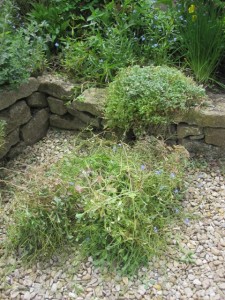Every so often it is a good idea to step back and take an objective look at our gardens (or any aspect of our lives actually), it is all too easy to stop seeing. Our garden borders are living things, they are competitive places where some of the less able species may need a little helping hand from the gardener.
Yesterday I took some time out to cast a critical eye over my borders, I asked myself lots of questions: which plants have got out of proportion with the surrounding plants? What can be clipped? What would be better removed? Where is the colour? Are plants repeated enough? Are the colours working well together? Is there enough height? Are leaf and flower shapes interesting? What should be moved in the autumn, etc… I jotted down a long list of improvements, some of which I could start immediately, the remainder have been filed in my diary for November.
I spent the rest of the day implementing my plan being ruthless, re-asserting myself as boss in the garden. Myosotis, Euphorbia Chamaeleon and the lovely pale yellow Welsh poppy (Meconopsis cambrica) were ruthlessly dug up from beds where they were not meant to be. I am all for self seeding, Aquilegia, Nemophilla, Lunaria, Myosotis, Meconopsis, Digitalis, etc… are all tolerated to a degree in my borders however light handed management helps to give a bit of space to the other plants too.
I like to work with nature in my garden particularly as I like it to link with the wider countryside, it is also the best approach for lower maintenance and produces a softer more naturalistic effect as in cottage, woodland, steppe and prairie gardens.
I thought my borders were relatively weed free but when I got right in there it was interesting what I found: foliage sheltering weeds with weeds protecting yet more weed seedlings and a surprising number of conclaves of romantic snails!
Nepeta ‘Six Hills Giant’ was given the ‘Chelsea chop’ where it was smothering other plants. The Arabis that has flowered for months, was given a short back and sides reshaping it into neat cushions and the hellebores, now great lush plants with heavy flower heads, were dead headed and untidy foliage removed.
I feel the plants in my borders can breath a bit better now, the air can circulate around my roses to cut down on disease, everything is a little more in proportion, there are fewer seeding weeds, fewer breeding snails and my compost bin has been re-fuelled.
